电视设计基础
- 格式:pps
- 大小:5.31 MB
- 文档页数:12
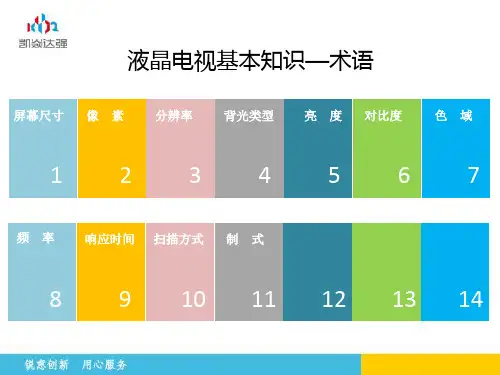
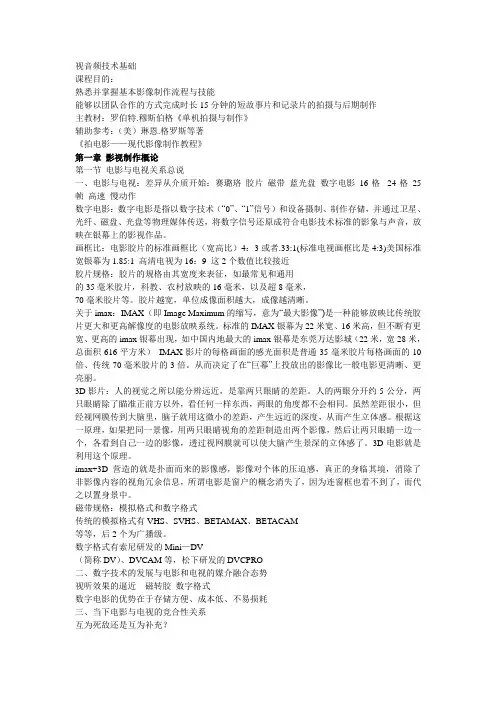
视音频技术基础课程目的:熟悉并掌握基本影像制作流程与技能能够以团队合作的方式完成时长15分钟的短故事片和记录片的拍摄与后期制作主教材:罗伯特.穆斯伯格《单机拍摄与制作》辅助参考:(美)琳恩.格罗斯等著《拍电影——现代影像制作教程》第一章影视制作概论第一节电影与电视关系总说一、电影与电视:差异从介质开始:赛璐珞胶片磁带蓝光盘数字电影16格-24格25帧高速慢动作数字电影:数字电影是指以数字技术(“0”、“1”信号)和设备摄制、制作存储,并通过卫星、光纤、磁盘、光盘等物理媒体传送,将数字信号还原成符合电影技术标准的影象与声音,放映在银幕上的影视作品。
画框比:电影胶片的标准画框比(宽高比)4:3或者.33:1(标准电视画框比是4:3)美国标准宽银幕为1.85:1 高清电视为16:9 这2个数值比较接近胶片规格:胶片的规格由其宽度来表征,如最常见和通用的35毫米胶片,科教、农村放映的16毫米,以及超8毫米,70毫米胶片等。
胶片越宽,单位成像面积越大,成像越清晰。
关于imax:IMAX(即Image Maximum的缩写,意为“最大影像”)是一种能够放映比传统胶片更大和更高解像度的电影放映系统。
标准的IMAX银幕为22米宽、16米高,但不断有更宽、更高的imax银幕出现,如中国内地最大的imax银幕是东莞万达影城(22米,宽28米,总面积616平方米)IMAX影片的每格画面的感光面积是普通35毫米胶片每格画面的10倍、传统70毫米胶片的3倍。
从而决定了在“巨幕”上投放出的影像比一般电影更清晰、更亮丽。
3D影片:人的视觉之所以能分辨远近,是靠两只眼睛的差距。
人的两眼分开约5公分,两只眼睛除了瞄准正前方以外,看任何一样东西,两眼的角度都不会相同。
虽然差距很小,但经视网膜传到大脑里,脑子就用这微小的差距,产生远近的深度,从而产生立体感。
根据这一原理,如果把同一景像,用两只眼睛视角的差距制造出两个影像,然后让两只眼睛一边一个,各看到自己一边的影像,透过视网膜就可以使大脑产生景深的立体感了。

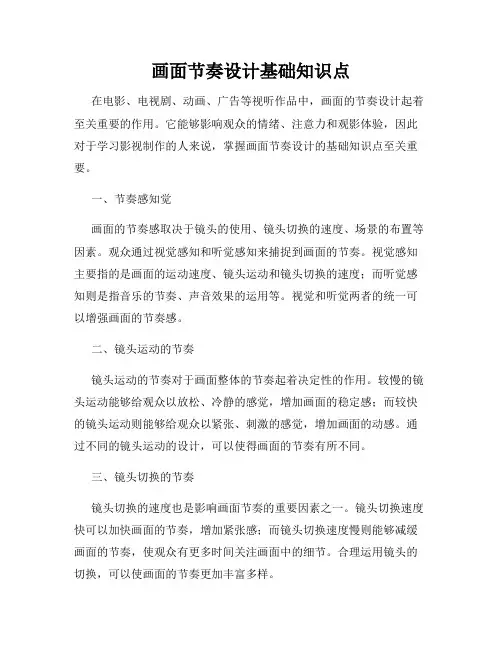
画面节奏设计基础知识点在电影、电视剧、动画、广告等视听作品中,画面的节奏设计起着至关重要的作用。
它能够影响观众的情绪、注意力和观影体验,因此对于学习影视制作的人来说,掌握画面节奏设计的基础知识点至关重要。
一、节奏感知觉画面的节奏感取决于镜头的使用、镜头切换的速度、场景的布置等因素。
观众通过视觉感知和听觉感知来捕捉到画面的节奏。
视觉感知主要指的是画面的运动速度、镜头运动和镜头切换的速度;而听觉感知则是指音乐的节奏、声音效果的运用等。
视觉和听觉两者的统一可以增强画面的节奏感。
二、镜头运动的节奏镜头运动的节奏对于画面整体的节奏起着决定性的作用。
较慢的镜头运动能够给观众以放松、冷静的感觉,增加画面的稳定感;而较快的镜头运动则能够给观众以紧张、刺激的感觉,增加画面的动感。
通过不同的镜头运动的设计,可以使得画面的节奏有所不同。
三、镜头切换的节奏镜头切换的速度也是影响画面节奏的重要因素之一。
镜头切换速度快可以加快画面的节奏,增加紧张感;而镜头切换速度慢则能够减缓画面的节奏,使观众有更多时间关注画面中的细节。
合理运用镜头的切换,可以使画面的节奏更加丰富多样。
四、音乐的节奏音乐是画面节奏设计中不可或缺的重要因素。
通过音乐的节奏,能够增强画面的冲击力和感染力。
快节奏的音乐能够增加画面的紧张感,让观众更容易感受到画面中的动感;而慢节奏的音乐则能够营造出一种宁静、安详的氛围,增加画面的稳定感。
五、场景的布置场景的布置也是画面节奏设计的重要要素之一。
不同的场景能够给观众带来不同的情感和感受。
例如,狭小的空间可以给人一种压抑感和紧张感,增加画面的紧凑感;而宽敞明亮的场景则会给人一种开放、轻松的感觉,增加画面的活力。
六、色彩的运用色彩的运用也是影响画面节奏的重要因素之一。
明亮的色彩能够使画面充满活力,增加画面的动感;而暗淡的色彩则能够给人一种安静、压抑的感觉,增加画面的稳定感。
通过合理运用色彩,可以增强画面的节奏感。
综上所述,画面节奏设计是影视制作中十分重要的一环。

影视制作的基础知识影视制作的基础知识1、帧和帧速率20世纪最后十年,无论是广播电视还是电影行业,都在数字化的大潮中驶过。
的确,由于数字技术的发展和广泛应用,不仅使这一领域引入了全新的技术和概念,而且也给这一领域的节目制作、传输和播出都带来了革命性变化。
数字技术的发展速度已经超乎于一般人的预料和想象。
像电影一样,视频是由一系列的单独图像(称之为帧)组成的,并放映到观众面前的屏幕上。
每秒钟放24~30帧/秒,这样才会产生平滑和连续的效果。
在正常情况下,一个或者多个音频轨迹与视频同步,并为影片提供声音。
帧速率也是描述视频信号的一个重要概念,对每秒钟扫描多少帧有一定的要求,这就是帧速率。
对于PAL制式电视系统,帧速率为25帧,而对于NTSC 制式电视系统,帧速率为30帧。
虽然这些帧速率足以提供平滑的运动,但它们还没有高到足以使视频显示避免闪烁的程度。
根据实验,人的眼睛可觉察到以低于1/50秒速度刷新图像中的闪烁。
然而,要求帧速率提高到这种程度,要求显著增加系统的频带宽度,这是相当困难的。
为了避免这样的情况,全部电视系统都采用了隔行扫描方法。
2、Premiere 6.0中常用图像文件格式介绍Premiere 6.0中常用的图像文件格式总共有12种,现在分别对它们进行简单介绍。
1).GIF格式GIF格式(图形交换格式)形成一种压缩的8位图像文件,这种格式的文件目前多用于网络传输,它可以指定透明的区域,以使图像与页背景很好地融为一体。
GIF图像可以随着它下载的过程,从模糊到清晰逐渐演变显示在屏幕上。
Animated GIF(动画GIF)图像可使网页生动活泼,上网的人肯定已经有所体会。
利用GIF动画程序,把一系列不同的GIF图像集合在一个文件里,这种文件可以和普通GIF文件一样插入网页中,GIF格式的不足之处在于它只能处理256色,不能用于存储真彩色图像。
6).PCX格式PCX格式最早是Zsoft公司的PC Paintbrush图像软件所支持的图像格式,它的历史较长,是一种基于PC机绘图程序的专用格式。
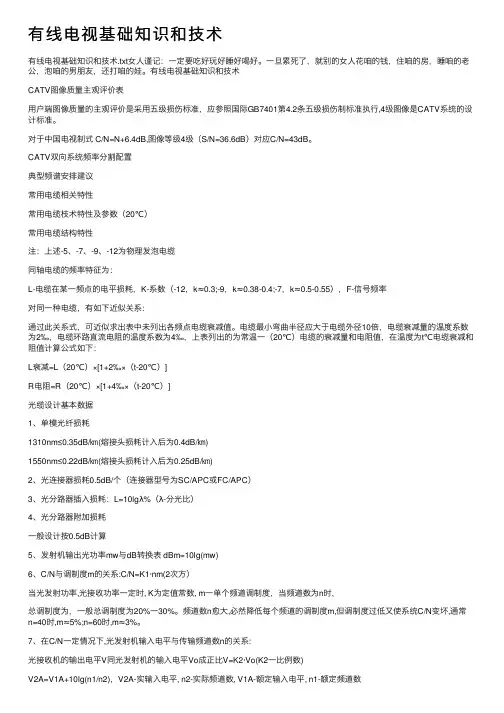
有线电视基础知识和技术有线电视基础知识和技术.txt⼥⼈谨记:⼀定要吃好玩好睡好喝好。
⼀旦累死了,就别的⼥⼈花咱的钱,住咱的房,睡咱的⽼公,泡咱的男朋友,还打咱的娃。
有线电视基础知识和技术CATV图像质量主观评价表⽤户端图像质量的主观评价是采⽤五级损伤标准,应参照国际GB7401第4.2条五级损伤制标准执⾏,4级图像是CATV系统的设计标准。
对于中国电视制式 C/N=N+6.4dB,图像等级4级(S/N=36.6dB)对应C/N=43dB。
CATV双向系统频率分割配置典型频谱安排建议常⽤电缆相关特性常⽤电缆枝术特性及参数(20℃)常⽤电缆结构特性注:上述-5、-7、-9、-12为物理发泡电缆同轴电缆的频率特征为:L-电缆在某⼀频点的电平损耗,K-系数(-12,k≈0.3;-9,k≈0.38-0.4;-7,k≈0.5-0.55),F-信号频率对同⼀种电缆,有如下近似关系:通过此关系式,可近似求出表中未列出各频点电缆衰减值。
电缆最⼩弯曲半径应⼤于电缆外径10倍,电缆衰减量的温度系数为2‰,电缆环路直流电阻的温度系数为4‰,上表列出的为常温⼀(20℃)电缆的衰减量和电阻值,在温度为t℃电缆衰减和阻值计算公式如下:L衰减=L(20℃)×[1+2‰×(t-20℃)]R电阻=R(20℃)×[1+4‰×(t-20℃)]光缆设计基本数据1、单模光纤损耗1310nm≤0.35dB/㎞(熔接头损耗计⼊后为0.4dB/㎞)1550nm≤0.22dB/㎞(熔接头损耗计⼊后为0.25dB/㎞)2、光连接器损耗0.5dB/个(连接器型号为SC/APC或FC/APC)3、光分路器插⼊损耗:L=10lgλ%(λ-分光⽐)4、光分路器附加损耗⼀般设计按0.5dB计算5、发射机输出光功率mw与dB转换表 dBm=10lg(mw)6、C/N与调制度m的关系:C/N=K1·nm(2次⽅)当光发射功率,光接收功率⼀定时, K为定值常数, m⼀单个频道调制度,当频道数为n时,总调制度为,⼀般总调制度为20%⼀30%。
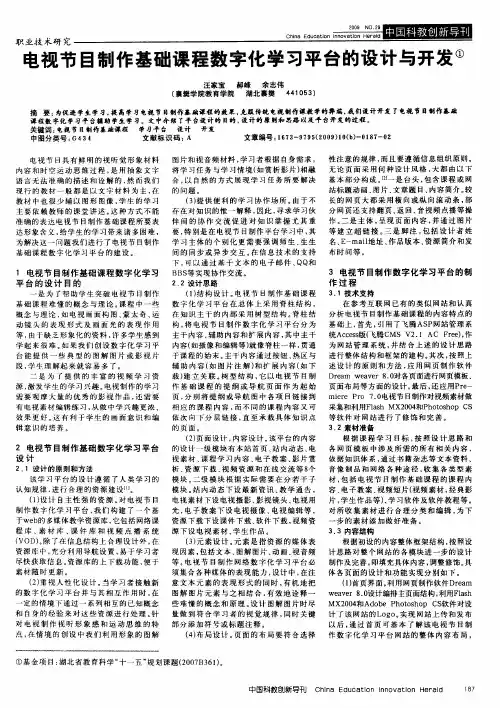
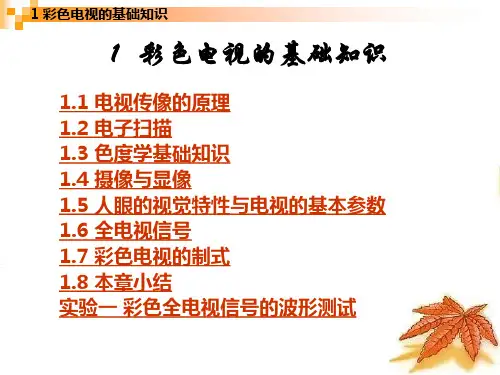
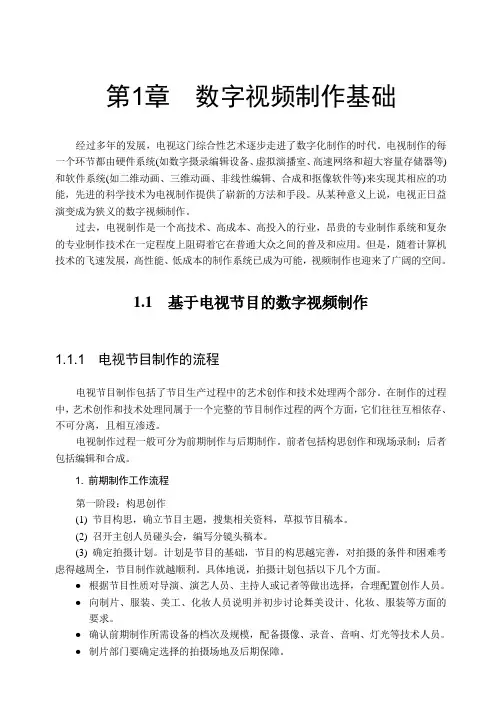
第1章数字视频制作基础经过多年的发展,电视这门综合性艺术逐步走进了数字化制作的时代。
电视制作的每一个环节都由硬件系统(如数字摄录编辑设备、虚拟演播室、高速网络和超大容量存储器等)和软件系统(如二维动画、三维动画、非线性编辑、合成和抠像软件等)来实现其相应的功能,先进的科学技术为电视制作提供了崭新的方法和手段。
从某种意义上说,电视正日益演变成为狭义的数字视频制作。
过去,电视制作是一个高技术、高成本、高投入的行业,昂贵的专业制作系统和复杂的专业制作技术在一定程度上阻碍着它在普通大众之间的普及和应用。
但是,随着计算机技术的飞速发展,高性能、低成本的制作系统已成为可能,视频制作也迎来了广阔的空间。
1.1 基于电视节目的数字视频制作1.1.1 电视节目制作的流程电视节目制作包括了节目生产过程中的艺术创作和技术处理两个部分。
在制作的过程中,艺术创作和技术处理同属于一个完整的节目制作过程的两个方面,它们往往互相依存、不可分离,且相互渗透。
电视制作过程一般可分为前期制作与后期制作。
前者包括构思创作和现场录制;后者包括编辑和合成。
1. 前期制作工作流程第一阶段:构思创作(1) 节目构思,确立节目主题,搜集相关资料,草拟节目稿本。
(2) 召开主创人员碰头会,编写分镜头稿本。
(3) 确定拍摄计划。
计划是节目的基础,节目的构思越完善,对拍摄的条件和困难考虑得越周全,节目制作就越顺利。
具体地说,拍摄计划包括以下几个方面。
●根据节目性质对导演、演艺人员、主持人或记者等做出选择,合理配置创作人员。
●向制片、服装、美工、化妆人员说明并初步讨论舞美设计、化妆、服装等方面的要求。
●确认前期制作所需设备的档次及规模,配备摄像、录音、音响、灯光等技术人员。
●制片部门要确定选择的拍摄场地及后期保障。
●各部门的主要负责人讨论、确定拍摄计划并执行等。
(4) 各部门细化自己的计划,如起草租赁合同,建造场景,制作道具,征集影片、录像资料等。
第二阶段:现场录制不同类型的节目有其不同的制作方式,下面以演播室拍摄为例进行讲解。
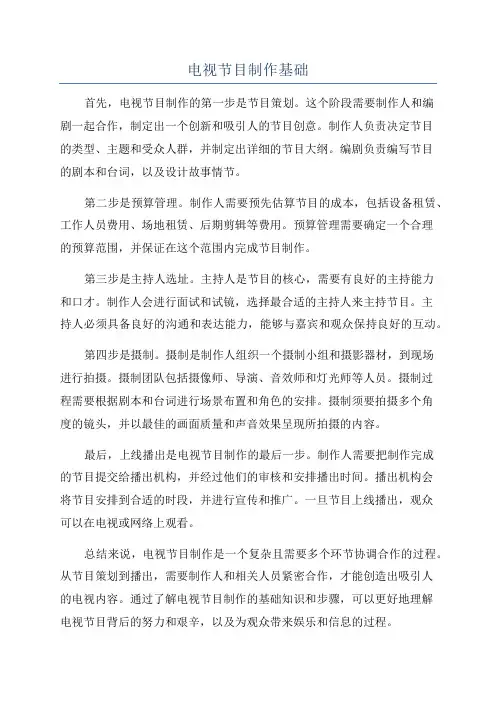
电视节目制作基础首先,电视节目制作的第一步是节目策划。
这个阶段需要制作人和编剧一起合作,制定出一个创新和吸引人的节目创意。
制作人负责决定节目的类型、主题和受众人群,并制定出详细的节目大纲。
编剧负责编写节目的剧本和台词,以及设计故事情节。
第二步是预算管理。
制作人需要预先估算节目的成本,包括设备租赁、工作人员费用、场地租赁、后期剪辑等费用。
预算管理需要确定一个合理的预算范围,并保证在这个范围内完成节目制作。
第三步是主持人选址。
主持人是节目的核心,需要有良好的主持能力和口才。
制作人会进行面试和试镜,选择最合适的主持人来主持节目。
主持人必须具备良好的沟通和表达能力,能够与嘉宾和观众保持良好的互动。
第四步是摄制。
摄制是制作人组织一个摄制小组和摄影器材,到现场进行拍摄。
摄制团队包括摄像师、导演、音效师和灯光师等人员。
摄制过程需要根据剧本和台词进行场景布置和角色的安排。
摄制须要拍摄多个角度的镜头,并以最佳的画面质量和声音效果呈现所拍摄的内容。
最后,上线播出是电视节目制作的最后一步。
制作人需要把制作完成的节目提交给播出机构,并经过他们的审核和安排播出时间。
播出机构会将节目安排到合适的时段,并进行宣传和推广。
一旦节目上线播出,观众可以在电视或网络上观看。
总结来说,电视节目制作是一个复杂且需要多个环节协调合作的过程。
从节目策划到播出,需要制作人和相关人员紧密合作,才能创造出吸引人的电视内容。
通过了解电视节目制作的基础知识和步骤,可以更好地理解电视节目背后的努力和艰辛,以及为观众带来娱乐和信息的过程。
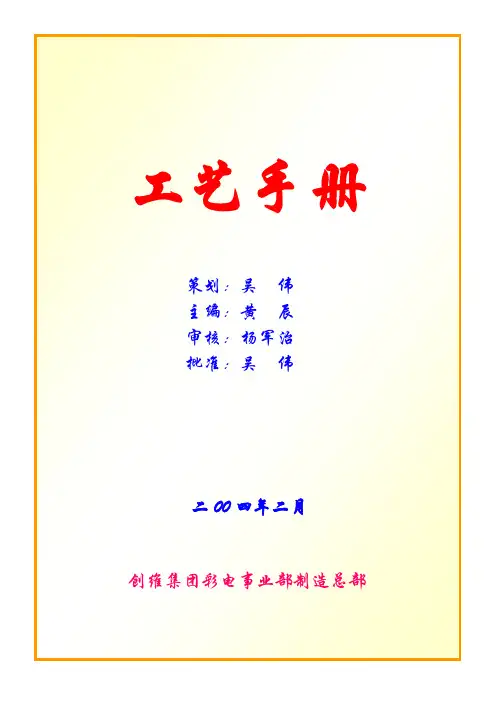
前言有这样一句普及科学的口号,叫做“知识就是力量”,意即只要掌握了一定的知识,就能具有改变世界和创造财富的力量。
我们创维公司主要是生产彩电的,我们的大多数员工从事的工作是彩电的装配、调试和检验,因此都需要了解和掌握比较全面的与彩电生产有关的工艺知识。
为此,吴伟总工程师在半年前要求工程部编著一本内容详细、全面、通俗易懂的《工艺手册》,发给公司每个员工人手一册,来提高大家的工艺技术水平。
由工程部的工艺室接受了这个特殊的编书任务,要求在保证旺季生产日常工艺工作不受影响的前提下,抽出时间来搞这项工作。
副经理黄辰总负责,先列出提纲,由工艺师朱凯坤、倪凯兵、向万里、陈林春、李茜、龚贵妃、朱江和黄辰分工编制有关的工艺知识内容,然后由黄辰统一进行修改和补充,汇编成册,最后经杨军治经理审核,吴伟总工程师批准。
下面谈一下工艺手册的内容构成。
工艺这个词的意思很难准确地解释,在英语中工艺和技术是同义词,按我们的理解,技术应该分为研发技术和生产技术,而工艺是指生产技术。
所以工艺手册的内容应该包括与彩电生产过程相关的各种知识。
工艺手册的内容共分为五篇,为了让新员工对电视和工艺的基础知识有所了解和掌握,所以第一篇内容为《电视基础知识》,第二篇内容为《工艺基础知识》。
后三篇内容介绍的是彩电生产从头至尾各个工序的操作步骤和要求,如第三篇为《插件、焊接和装配》、第四篇为《调试、检验和修理》,由于整机调试和检验的内容比较多,就从第四篇中分出,单独成为第五篇《整机调试和检验》。
我们在编制过程中参考了工程部电路组、工艺进步组和工装室编制的一些工序标准和工装使用说明,参考了技服和设计师的一些产品功能介绍,在此谨向他们表示谢意!现在这本“工艺手册”几经修改,终于编成。
由于我们第一次编书,水平和时间有限,书中的错误和不足肯定是有的,希望大家提出宝贵意见。
但我们还是要把它作为工程部献给创维公司和每个员工的一份新年礼物,希望它能助你一臂之力。
在新的一年中,我们还计划把《工艺手册》再进一步完善和扩大内容范围,编制一个网络版本,能不限篇幅和及时更新,使《工艺手册》发挥更大的作用。
iptv电视设计方案IPTV(Internet Protocol Television)是一种基于互联网传输技术的电视服务,通过远程服务器将电视信号、专网点播、互动服务等内容传输到用户的电视终端。
本文将提出一个IPTV电视设计方案,旨在提供用户高质量的电视观看体验。
1. 概述IPTV电视设计方案的核心目标是提供高质量的电视广播和点播服务。
该方案包括服务器端设备、客户端设备、网络基础设施以及互动服务平台。
2. 服务器端设备服务器端设备是IPTV电视设计方案的关键组成部分。
它承担着内容存储、流媒体传输和数据管理等功能。
服务器端设备应具备高处理能力、大存储容量和稳定性能,以满足大规模用户同时观看的需求。
3. 客户端设备客户端设备是IPTV电视设计方案的用户终端,包括电视机、机顶盒、智能手机和平板电脑等。
客户端设备应具备良好的用户界面和操作体验,支持高清视频播放和互动功能,并且兼容各种网络接入方式,如局域网、Wi-Fi和4G等。
4. 网络基础设施网络基础设施是IPTV电视设计方案的基础环境,包括宽带接入、传输网络和接入网等。
网络基础设施应具备高带宽、低延迟和高可靠性,以提供快速稳定的数据传输,确保用户的观看体验。
5. 互动服务平台互动服务平台是IPTV电视设计方案的增值功能,包括点播、直播、互动游戏和社交媒体等。
互动服务平台应具备丰富多样的内容供用户选择,支持个性化推荐和自定义播放列表,以满足不同用户的需求。
6. 安全性IPTV电视设计方案要重视用户隐私和内容安全。
通过加密传输和数字版权管理等措施,保护用户隐私不被侵犯,并确保内容的合法性和版权保护。
7. 质量保证为了确保用户的高质量观看体验,IPTV电视设计方案需要进行质量保证。
通过监控和管理系统,及时识别和解决网络故障和服务中断,提供24小时的技术支持和售后服务。
8. 用户体验不仅要提供高清晰度的视频内容,IPTV电视设计方案还要关注用户体验的便利性和个性化需求。
电视台演播厅的基础构建技术电视台演播厅是电视台节目制作的重要场所,它的基础构建技术直接关系到节目制作的质量和效果。
电视台演播厅的基础构建技术包括场地选址、建筑设计、灯光音响设备、舞美布景、摄像机设备等方面,这些要素的合理配置和设计是电视台演播厅基础构建的关键。
电视台演播厅的场地选址是基础构建技术的第一步。
场地选址要考虑到周边环境、交通便捷性和用电供应等因素。
电视台演播厅应该选址在交通便利、用电供应充足的地方,同时周边环境安静、无污染是非常重要的。
演播厅的场地面积也要考虑到节目制作的需要,足够的空间可以容纳各种设备和布景,也能更好地满足节目现场直播的要求。
建筑设计是电视台演播厅基础构建的重要环节。
演播厅的建筑设计要符合现代化的节目制作需求,包括通风、采光、空调、消防等设施的设计。
建筑结构也要能够支撑灯光音响设备的安装,以及摄像机的布置。
演播厅内部的设计也要考虑节目类型和风格,不同类型的节目需要不同的舞美布景和观众席布置,建筑设计要能够满足这些需求。
灯光音响设备是电视台演播厅基础构建的重点之一。
合理的灯光设计可以提高节目的视觉效果,不同的灯光效果可以为不同类型的节目营造出氛围,加强节目的表现力和观赏性。
音响设备的配置也是至关重要的,清晰的声音可以改善节目质量,给观众更好的观看体验。
灯光音响设备的布置和控制系统也是重要的技术环节,设备的互相配合和控制可以使节目现场更加精彩。
舞美布景是电视台演播厅基础构建的重要组成部分。
舞美布景的设计要与节目类型和风格相匹配,能够提供合适的背景和布景,使得节目更加生动有趣。
舞美布景的制作质量也影响着节目的形象,高质量的舞美布景可以提升节目的档次和观赏性。
摄像机设备是电视台演播厅基础构建的关键设备之一。
高质量的摄像机设备可以提供清晰稳定的画面,保证节目制作的效果和质量。
在现场直播节目中,摄像机设备的布置和操作技术也是非常重要的,摄像师的水平和经验直接关系到节目的表现。
色彩基础知识了解图像的色彩模式对于后面编辑工作的学习有着非常重要的作用。
对于一个致力于计算机图像图形设计的人来说,熟练掌握色彩的继承知识,是做好工作的前提条件。
色彩模式显示世界中的对象如果在计算机中表现出来,必须依靠不同的配色方式来实现。
下面,将介绍几种常用的配色方式。
1.色彩模式RGB是由红、绿、蓝三原色组成的色彩模式。
图像中所有的色彩都是由三原色组合而来。
所谓三原色,即指不能由其他色彩组合而成的色彩。
三原色并不是固定不变的,例如红、黄、蓝也被称为三原色。
三原色每个都可包含256种亮度级别,三个通道合成起来就可显示完整的彩色图像。
我们的电视机或监视器等视频设备,就是利用三原色进行彩色显示的。
在视频编辑中,RGB是唯一可以使用的配色方式。
在RGB图像中的每个通道可包含2的8次方个不同的色调。
我们通常所提到的RGB图像包含三个通道,因而在一幅图像中可以有2的24次方(约1670万)种不同的颜色。
如果以等量的三原色光混合,可以形成白光。
三原色中红和绿等量混合则成为黄色;绿和蓝光等量混合为青色;红和蓝等量混合为品红色。
在Premiere中调节对象色彩,可以通过对红、绿、蓝三个通道的数值进行调节,来改变图像的色彩。
三原色中每一种都有一个0~255的取值范围。
当三个值都为0时,图像为黑色,当三个值都为255时,图像为白色。
2.灰度模式灰度图像模式属于非彩色模式。
它只包含256级不同的亮度级别,只有一个Black 通道。
用户在图像中看到的各种色调都是由256种不同强度的黑色所表示的。
灰度图像中的每个像素的颜色都要用8位二进制存储。
3.CMYK色彩模式CMYK是指青色(cyan)、品红(magenta)、黄色(yellow)和黑色(black)。
它是用于制作高质量彩色出版物的颜色模式。
CMYK是一种减色配色方式。
当几种颜色合起来时,将得到黑色。
这与RGB模式正好相反。
B色彩模式Lab是一种图像软件用来从一种颜色模式向另外一种颜色模式转变的内部颜色模式。
Basic TV Course Video and SynchronizationProcessingList of content•Basic Function Block of TV system•Human vision in TV & Interlacing scan•Synchronization processing in TV–Phase-1 loop / Phase-2 loop / Sandcastle•CVBS signal & World conventional color TV standard–NTSC / PAL / SECAM•PAL / NTSC / SECAM Video Signal encoding•PAL/ NTSC/ SECAM System decoding•Luminance Signal processing as picture improvement –Peaking / LTI / CTI–Signal level stretch: Black / Blue / White level–Soft Clipping / Peak White Limiting–HistogramPrepared by: Wang Guo Ji Oct 2000Function Block of Video SystemFig. Basic TV system C prism R/G/B •Gammacorrection/VideoencoderScanningControl Synchro-nizationProcessorVideo Processing Sync Separation Deflection & EHT. GenerationCVBS ScanCurrent H/V Syncpulse Blanking pulse R/G/B Driver H/V pulse EHTScancurrent R/G/B CVBS IF&RFmodulatorTuner&IF Demodulator Source Selection Synchro-nization processor H/V drive TransmissionReceiver•Human visual perception to Red, Green ,BlueThe major light sensing element in the human eye is the retina. The retina consists of the major light receptors ---rods and cones which at the bottom of the retina.Image is formed by the light that reaching the main photoreceptors. Research shows that red, green and blue colors are the primary colors, as "If you mix light of these colors together you can make any color". They lie in the nature of the human eye.Some colors could have by following experiments :Projectorscreen•Understanding of visual persistence with human visionThe human eye retains an image for a fraction of a second after it views the image. This property (called persistence of vision) is essential to all visual display technologies. The still images are presented at a high enough frame repetition rate so that persistence of vision integrates these still images into motion. For some reason, The motion pictures was found to be unacceptable when image repetition rate is below 48 frames per second.Therefor to realize the repetition rate of 48 frame per second, in the television system one picture frame is splited into two fields, and the field frequency is defined as 50Hz or 60Hz (higher than 48Hz) determined by the video system. 50Hz/60Hz field repetition rate gives normal perception to the image on TV screen. The idea is that a single frame is scanned twice(see Fig. Interlacing lines). The first field scan includes only the odd lines, the next field scan includes only the even lines. With this method, the number of "flashes" per frame is two, and the field rate is just double the frame rate so that 50hz/60hz field rate has their frame rate at 25/30Hz in TV.The 50Hz field scan system contains 625 horizontal lines per frame and each field scans 312.5 lines. The 60Hz field scan system contains 525 lines per frame, each field scans 262.5 lines.•Interlaced Frame ScanScreen framefirst fieldstartsecond field startFig. Interlacing lines•Presentation of interlacing scanning In a TV, the electron beam is used to scan a phosphor screen. The scan is interlaced.For each horizontal line scan the information is always displayed from left to right, after each line is written, the signal is blanked, the beam starts returning back to the left. When the signal reached the bottom it is blanked until it returns to the top to write the first line in next field. the beam does not return directly to the top, but zig-zags route. See Fig. Demonstration of real scanning sequenceScreen framefirst fieldstartsecond field startFig. Demonstration of real scanning sequenceSynchronization components of video signal•Video signals during blanking period Timing of scanning is arranged by the sync pulses. Each field scan starts with a vertical sync, each line scan starts with a horizontal pulse. The horizontal and vertical blanking period are specified around the sync pulses. With blanking period the electron beam complete its fly-back from the right to the left for horizontal scan or from the bottom to the top of screen for field scan. During the period the electron beam is cutoff, so that no scan line is visible on the screen.The combination of horizontal blanking signal and synchronization pulse is defined as illustrated in Fig. Sync Signal during horizontal blanking period. For color signals, a so called …color burst‟ is inserted onto the "back porch”of the H sync, that carries the color system info.for use in color decoder(more on this later). The burst period is about 8-10 cycle time of the sub-carrier (info.)Fig. 50Hz Sync Signal duringhorizontal blanking periodSynchronization components of video signal•Video signal during one line period In time domain,the video signal may be diverted into two period --that is,blanking and scan period. Signal during blanking period is sent to the synchronization processor to re-generate the timing reference (horizontal and vertical drive signals) for picture scanning, the signal during scan period is sent to video processing function block (see Fig. Horizontal video signal),from which the primary color R,G,B are decoded and as the driver signal output topicture tuber. frontporchsyncpulsebackporchblankingimage signalscan periodBlack levelPeak white levelFig. Horizontal video signalSynchronization components of video signal•Video signal during field blanking period Signal during vertical blanking also has a number of synchronization pulses included. It is illustrated in Fig. Horizontal and vertical …mixed-syncs‟ signal. The pre-equalizing and post-equalizing are built to provide the horizontal synchronization during vertical retrace period, in order to have precise starting-point for each scanning field. (info.)For a picture re-production, the horizontal and vertical scan must be in synchronized with the input video signal. This is to re-establish the timing reference for picture scanning from the incoming video signal by the synchronization processor in receiver. It extracts the sync signal from the incomingvideo signal, re-generate the H drive and vertical drive signal with proper display timing incorporated.See Fig. Block diagram of sync processor .System synchronization in TVH.Sync separator 1st PhasecomparatorLow-pass filterH.V.C.OVertical sync separator -divider (625 or 525)-counterCoincidence detectorVertical SAW-tooth OSCCVBS input2nd Phase detectorH.drive outputSandcastle generationV.driveoutputFlyback in/sandcastle outH.driveV.drive Fig. Block diagram of sync processor .System synchronization in TV•Sync separationby applying a slicing level between the top sync and the black level the sync info may be separated from the video signal. The separated sync pulse stream consists of horizontal and vertical sync info. thatintended to control both timing of the horizontal and vertical scan.See Fig. Separation of the horizontal syncCVBS inputBASeparated syncH.Sync separatorSync slicing levelFig. Separation of the horizontal syncFig. A simple single-transistor sync separatorC1R1R2ReRcI_scanCVBSinputpulses output47u47u ABR3composite sync •A simple sync separation circuit -When sync pulses come, T is conducting and C1is charged through the emitter-base of transistor. As result the sync pulse stream are available across Rc at B .-During scan period, I-scan is discharge current from C1, transistor cuts off. C1sees high input-impedance. No signal output at B .-The slicing level may be adjusted by the biasing of Transistor, for which R2,R3,Re may be included.•Sync separation and Sync auto slicing CircuitR A1-+A2A3-+Clamping'low' to blackClampped CVBSabc absync slicing levelseperated syncblack levelc•Separation of Vertical syncThe sync separation outputs composite sync signal that a stream of mixed horizontal and vertical sync pulses.see Fig. Stream of composite sync pulses.Fig. Stream of composite sync pulsesThis sync stream may be used directly for horizontal synchronization after gating (more on later). But for vertical synchronization, It requires further process in order to have a real vertical sync pulse because during the vertical sync pulse period, it sees a double line rate sync pulses in the stream. The vertical sync separation can be carried out by using a simple mono-stable circuit in which the arrival of the broad pulses are detected. Such a circuit is shown in Fig. Vertical sync separated by simple mono-stable circuit,note that the output of separated vertical sync-pulses required to be further processed in order to form the real vertical sync signal.•Vertical sync seperator•Vertical sync pulse is to be separated from the composite syncpulse.•vertical separator circuit.ABSystem synchronization in TV+ Fig. Vertical sync separated by simple mono-stable circuitHorizontal and Vertical scan SynchronizationHorizontal synchronization processing includes two loops control that is, phase1 and phase2 loop control. Phase1 loop control consists of a voltage controlled saw tooth oscillator and a phase comparator. Phase1 loop control is to make the saw-tooth oscillator in synchronized with the incoming horizontal sync pulses, it generates the horizontal reference pulse for sync system usage. see Fig. Function diagram of phase1 loop. Phase2 loop is to control the shift of timing to horizontal drive pulse to adjust display position of picture on screen(more on later).•Operation of PH1 Loop In Fig. Function diagram of phase1 loop, the voltage controlled saw-tooth generator generates the horizontal saw-tooth signal. An error voltage that fed from the phase comparator (through LFP) may control the oscillating frequency higher or lower. Conversion of saw-tooth to horizontal reference pulse is done in the oscillator. In the phase comparator, the reference pulse are comparing to the composite sync pulses with their phase. As result, the error signal in form of current signal passing through the external low pass filter applied to the saw-tooth generator.Fig. Function diagram of phase1 loopRCVH/VL lev el Detector Acurrent sourceswitchabv arible VL input error v oltaget1t2t3t4error voltageVHVLV(a) or V(b)•Principle of voltage controlled horizontal saw-tooth generatorBefore t1, switch is closed and C is charged by the current source. When V(b)=V H is detected, the switch is open. C is discharging via R, till V(a)= V L is detected, the switch is closed, capacitor C is re-charged again. The time constant of RC may be defined in such a way that the charging period equals to the scan period and the discharging period equals to the fly-back period. The error voltage derived from the phase comparator through LPF offsets the V L which determined by the error detected in the phase comparator.•Generating of horizontal reference pulseGenerating of horizontal reference pulse is illustrated in Fig. Generating of horizontal reference pulse . The threshold level as in (b) is about (VH+VL)/2.System synchronization in TVhorizonta syncshorizontal saw-toothhorizontal reference pulses(a)(b)(c)Fig. Generating of horizontal reference pulsesync pulseshoriz. Ref. pulsesgating pulsesIpos.Ineg.ouput current from phase discriminaorDC error voltage outputformed by LPF(a)(b)(c)(d)(e)Fig. Function of Phase comparator System synchronization in TV•Operation of phase comparator In phase comparator, incoming sync pulse is comparing to the horizontal reference pulse, from which the error current is converted to error voltage by means of low-pass filter. the error voltage is fed to the voltage controlled saw-tooth generator to control the oscillator frequency. See Fig. Function of Phase comparator.Example of a phase lock process. See below: in case of fsync > fosc,the error current from phasecomparator outputs asymmetrically in the current waveform which resulting different error voltagelevel.sync pulseshoriz. Ref. pulsesgating pulsesIpos.Ineg.current ouput fromphase comparatorThe increased Ipos periodresults a higher errorvoltage at the LPF output, thenthe saw-tooth frequency willbe increased.fsync > fosc•the negative charging is less than the positive charging time.•The average output current is positive.•The DC voltage at the o/p of LPF increases.•The voltage is fed to the voltage control saw-tooth oscillator as result the frequency will increase correspondingly.VtVFig. Error voltage at LPF outputIn real signal condition the video signal can be easily disturbed by the other signals, especially in off-air. With the disturbance, additional pulses may be added onto the video signal. they also may be mixed in as part of the composite sync. It causes unstable horizontal synchronization, for which gating pulse is formed to get rid of these disturbance. See Fig. Timing of gating pulseVref. 1Vref. 2saw-tooth and ref.flyback pulse of the saw-tooth osc.pulse 1pulse 2gating pulseABCA+B+CFig. Timing diagram of the gating pulseSystem synchronization in TVThe gating pulse is generated around the H. fly-back period.It sets a timing window for the sync pulses. The phasecomparator works only when gating pulse is high.Fig. preventing disturbances from "illegal" pulseshorz. Refincoming sync with 'illegal pulses output w/o gating pulsegating pulseoutput with gatingpulseThe function of gating pulse is illustrated in Fig. Preventing disturbance from “illegal pulses”The illegal pulses mixed in composite sync.Result in …false‟ error current output to LPF.“illegal” pulses is outside the window of gating.The “illegal pulses are rejected by window gating, no influence from disturbance.HH/22.5HH/22.5H 2.35us4.7us4.7ustop s yncblack leveleven field25HCan be removed by gating.Disturbance to the phase 1 control loop•The disturbance due to the vertical sync pulse will upset the oscillator.•The effect on screen if w/o gating/horizontal sync during Vertical blanking period:flutterTop flutter or top bendingTop bendingsync processor Hor.driv estorage delayTdHorizontal f ly -back pulseFig. Horizontal .drive and Horizontal .output•Principle of Phase2 loopthe phase 1 loop synchronizes the horizontal oscillator with the incoming video signal. The phase 2 is to provide a right timing and stable picture position. This is necessary because due to beam current variations that the storage time of the line output transistor varies See Fig. Horizontal drive and Horizontal output.,and the horizontal fly-back pulse required for the blanking purpose. In-correct timing of fly-back results in missing of picture contents.See Fig. Missing picture content by wrong blanking timing.System synchronization in TV•If directly use horizontal drive generated during phase1 loop (no timingcompensation to horizontal drive pulse). In worse case, fly-back pulse from LOT will goes into the picture scanning period.•As the Hor. Fly-back pulse is use to be a horizontal blanking pulse in the signal processing, at the beginning of each line some a small portion of picture content will be blanked.System synchronization in TVon offphase 2 comparatorline output stageHor. drive phase compensator+Vloop filterflyback from LOTPhase 2 Hor. ref. pulseH.dirve pulseHor.saw-toothFig. Function diagram of Phase 2To avoid wrong blanking timing. Phase 2 loop is to coordinate the timing adjustment between the H-drive and sync info. See Fig. Function diagram of phase 2 loop The phase 2 loop compares the horizontal reference with the horizontal fly-back pulse, which intend to compensate the time delay by re-generating the horizontal drive with the delay compensated. the error signal from phase 2 comparator is fed to timing compensator of horizontal drive for proper timing to horizontal drive.System synchronization in TVSystem synchronization in TVH.saw-tooth/ PH2 referenceVideo InputH. fly-backfrom LOTH-Drive pulse timingshifting by resultfrom PH2Vertical synchDirect synchronization--the vertical oscillator is triggered (synchronization) by the vertical syncpulses. The vertical sync pulse starts the vertical fly-back. When no sync, the vertical oscillator is in free running mode, at a lower frequency than the actual vertical frequency. see below for example of vertical direct synchronization.Where no vertical sync pulse, the vertical saw-tooth frequency f0is lower than the vertical frequency fv . When vertical sync pulse comes, it turns to start the vertical fly-back and bring f0 = fv .T1T2V+C T3vertical syncscan vertical syncA BA Bfree runningSystem synchronization in TV•The sandcastle pulse and its applicationduring the process of video processing, some operation such as clamping, burst gating, blanking...etc need timing reference signal, for which a so called …sandcastle‟ signal is generated in the synchronization processor. The sandcastle signal gets its name from the shape of the pulse. Its upper portion is taken from the incoming sync, lower portion from the horizontal fly-back pulse. See Fig.application of the sandcastle pulse andFig. Sandcastle pulseSystem synchronization in TVSystem synchronization in TVFig. Sandcastle pulseSystem synchronization in TV•Vertical dividerThe vertical divider system has a full integrated functionality of the vertical synchronization. It can handle both 50Hz or 60Hz standard system, or can be forced to desired system by IIC bus control. When in the searching mode the divider can catch between about 45 and 65HZ, in case of RGB input mode, the catching range is enlarged and ranges from 44 to 72Hz.Formation of CVBS video signal•Gamma Correction Because of the receiver CRT does not emit the light in direct proportion to the voltage applied between its grid and cathode,which may be expressed:L is the luminance on screen, V g is the grid/cathode voltage.To compensate for the non-linear CRT characteristic, an opposite law must be introduced at the studio source. If E is the camera voltage that resulting from a given light input L , then the gammacorrection may be expressed:The gamma standard used is 2.8 , which is close to a modern color display beam current/grid voltage characteristic and the drive circuit arrangement.()γgV L ∝()EE V L g ∝⎪⎪⎭⎫ ⎝⎛∝∝γγγ1•In studio the R,G,B signals are corrected with characteristics of γ=1/2.8.•Gamma correction in Studio and ReceiverGrey scale patternVin VinVin 0Bd BdBd+•On screen the CRT will emit the linear light to the eyes( γ= 1).•In TV receiver the gamma corrected R,G,B signalsare applied to drive the cathode of CRT by the grid/cathode modulation. γ==2.8•Normal view on screenFormation of CVBS video signalFormation of CVBS video signal•Color-Difference signalThe signal Y which represents the brightness information, was used in the monochrome television transmission service before color TV. But in color TV the RGB primary signals are required to drive CRT. In color TV, additional color-difference signals (R-Y) and (B-Y) were created to provide the color information. It is added to the Y signal after its modulation to the sub-carrier. In the receiver the (R-Y) and (B-Y) will be first demodulated from sub-carrier and sent to the matrix network with Y signal, thus recovers the primary R, G and B. This method of coding reduces redundancy in the combined signal and also remained compatible with black and white television. In a non-colored scene, color-difference signals are zero.As can seen:R=( R-Y ) + YB =( B-Y ) + Yfor G signal, may be recovered from these two color-difference signals by applying expression below: Y=0.299R + 0.587G + 0.114BWeighting factor for Color-Difference Signal To avoid over-modulation in RF modulation. The full-amplitude color difference component must be scaled down by weighting factors in coding and scale up in the decoding. Thus we have:V = 0.877( R-Y )U = 0.493( B-Y )V and U are the weighted color difference signal used in the encoder as a standard.•Formation of CVBS signalFormation of CVBS video signalFormation of CVBS video signal•chrominance phasor position expression as known,the U and V signal are created to carry the chrominance information. They may can be expressed in a coordinate U-V. See Fig. 100% color bar phasor expressionFig. 100% color bar phasor expression The dotted phasor position iscorresponding to the PAL line.In the coordinate, magnitude of vector may be expressed:that mainly determines the saturation of the color.Angle of the vector may be expressed as:that mainly determine the tone of a color.()22V U C +=U V arc tg =θ•Color television world standards There are three major TV standards used in the world today. These are the American NTSC(National Television Systems Committee) color television system, the European PAL (PhaseAlternation Line rate) and the French-Former Soviet Union SECAM (Sequential Couleur avecMemoire). All three systems use the same definition for luminance. The largest differencebetween the three systems is the vertical lines. NTSC uses 525 lines (interlaced) while both PALand SECAM use 625 lines. NTSC frame rates are slightly less than 1/2 the 60 Hz power linefrequency, while PAL and SECAM frame rates are exactly 1/2 the 50 Hz power line frequency.lines active vertical aspect horizontal frame ratelines resolution ratio resolutionNTSC 525 484 242 4/3 427 29.94PAL 625 575 290 4/3 425 25SECAM 625 575 290 4/3 465 25 •Chrominance signal of Color television world standardsin PAL and NTSC standards, U and V color difference signals are using amplitude modulation to the sub-carrier(AM) ,in SECAM U and V signal are using frequency modulation to the sub-carrier. After modulation, U and V are added to form chrominance signal. The modulation method differentials the difference of system between NTSC , PAL and SECAM system. The chrominance signal defines the difference between a color area and a neutral Grey of the same luminance, and the chromiance information embraces that part of the video signal which enables a color receiver to describe an area in color rather than in monochrome.NTSC chrominace signal:()()())33cos()33sin()(cos sin )(cos )(sin )()(︒++︒+=+=-+-=t t I t t Q t t V t t U t e tY R t Y B t e sc sc sc sc c sc sc c ωωωωωωMhzf s c 57954506.3=s c f πω2=In following fig. The positive polarity of Q is purple, the negative is green. The positive polarity of I isorange, the negative is cyan. Thus, Q is often called the "green-purple" or "purple-green" axisinformation and I is often called the "orange-cyan" or "cyan-orange" axis information.:Formation of CVBS video signalIt turns out that the human eye is more sensitive to spatial variations in the "orange-cyan" than it is for the "green purple". Thus, the "orange-cyan" or I signal has a maximum bandwidth of 1.5 MHz and the "green purple" only has a maximum bandwidth of 0.5 MHz. The Q and I signals are both modulated by a 3.58 MHz carrier wave. These two signals are then summed together to make the C or chrominance signal. this new chrominance signal (formed by I and Q) has the interesting property that the magnitude of the signal represents the color saturation, and the phase of the signal represents the hue.In the color decoder, the burst signal that carrys the phase reference information of chroma must besupplied with the chrominance signal. The burst is transmitted at “back porch”of each horizontal sync pulse during field scan.•Phase error of NTSC System the phase of the chrominance signal may be shifting according to the luminance level, if non-linear transmission characteristics happen to the system, it is so called …differential phase error ‟.As in the color decoder the reference sub-carrier is lock to the burst, a phase shifted chrominance signal after decoding will have phase error. Phase Shifted color difference signal resulting in a different color tone(hue ). In NTSC receiver a user controlled …TINT ‟ is required to correct hue manually.•Spectrum characteristics of NTSC signalChrominance signal of PAL may be expressed:()()()()()[]t t t C t ec tt V t t t U t e t Y R t K t Y B t e s c s c K s c c s c s c c θωωωωω+=Φ+=-Φ+-=sin co s )(sin )(co s ))((sin )()(s c f πω2=Mhzf sc 4296875.4=t3T H 2T H T H 0+1-1ΦK(t)•PAL chrominance signalIn PAL system, phase of the V signal is reversed by 180 degrees line by line. It is to reduce …differential phase error ‟ that causes distorted color tone.The V signal shifts its phase with 180 degree alternative line. Bandwidth for both U and V are approximately 1.3MHz.•Color Burst-Chrominance Sync The burst of sub-carrier is modulated on the back porch of each line-blanking period. It contains both the reference of frequency and phase information for usage in color decoder. In each burst, 10±1cycles of sub-carrier are transmitted.•Burst for NTSC system :()180)()(+=t Sin t K t e sc b ωThe burst in NTSC has fixed phase 180°.Formation of CVBS video signalNTSC linePAL lineNTSC line•Burst for PAL system :⎪⎭⎫ ⎝⎛Φ-︒+=4)(180)()(πωt K t Sin t K t e s c b The burst in PAL has phase shifting in alternative line. Magnitude of bust is 300mV .NTSC line: 135°,PAL line 225°.The difference of phase shifting is 90°line from line.•CVBS signal encoder for NTSC and PAL systemCVBS signal carries full information for a color television needs. It includes sync pulses and horizontal and vertical blanking information, luminance signaland chrominance signal(including burst and system information).•NTSC video encodersee Fig. Function diagram of NTSC encoderFormation of CVBS video signalColor system encoding•NTSC system encodingAB C D EF Gburst Hx2。